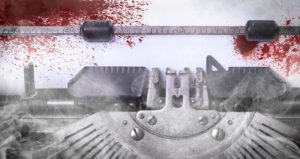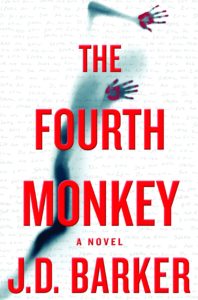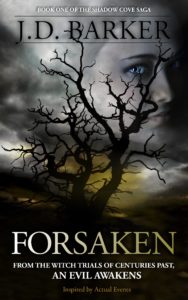 I just spent an hour on the phone with the man who, a couple of weeks ago, kept me up all night — turning the pages of his latest thriller. His name is J.D. Barker, and he’s an author who self-published his first novel, Forsaken, in 2014. Since then Forsaken, a supernatural thriller, has sold approximately 250,000 copies. As an audio book, Forsaken made $30,000 for J.D. in the first month of its release. After the book sold 13,000 copies in one week of 2015, it was scheduled for the New York Times bestseller lists — until the NYT discovered the novel was self-published. So far, Forsaken has earned between $250-300,000.
I just spent an hour on the phone with the man who, a couple of weeks ago, kept me up all night — turning the pages of his latest thriller. His name is J.D. Barker, and he’s an author who self-published his first novel, Forsaken, in 2014. Since then Forsaken, a supernatural thriller, has sold approximately 250,000 copies. As an audio book, Forsaken made $30,000 for J.D. in the first month of its release. After the book sold 13,000 copies in one week of 2015, it was scheduled for the New York Times bestseller lists — until the NYT discovered the novel was self-published. So far, Forsaken has earned between $250-300,000.
$1 Million for Second Novel

 J.D.’s serial-killer thriller The Fourth Monkey , his second novel, attracted the attention of the big traditional publishers. Two pre-emptive bids were made by Harcourt Mifflin Houghton in the U.S. and Harper Collins in the U.K. Additionally, there were advances from international sales, and for the rights to develop the book as a CBS-TV series. All of these, so far, add up to a cool $1 million dollars. Eight different studios are looking at the movie rights. I described The Fourth Monkey as the ultimate page-turning thriller after I stayed up all night to finish the book. It’s been a long time since I had to– just absolutely had to– finish a book in one sitting so naturally I was curious about the author.
J.D.’s serial-killer thriller The Fourth Monkey , his second novel, attracted the attention of the big traditional publishers. Two pre-emptive bids were made by Harcourt Mifflin Houghton in the U.S. and Harper Collins in the U.K. Additionally, there were advances from international sales, and for the rights to develop the book as a CBS-TV series. All of these, so far, add up to a cool $1 million dollars. Eight different studios are looking at the movie rights. I described The Fourth Monkey as the ultimate page-turning thriller after I stayed up all night to finish the book. It’s been a long time since I had to– just absolutely had to– finish a book in one sitting so naturally I was curious about the author.
Not An “Overnight” Success
Preliminary research included an article in The Pittsburgh Tribune-Review with the headline “Horror Author Finds Instant Success With 1st Novel.” I know there’s no such thing as “instant” or “overnight” success. So I dug deeper, and discovered that, as a writer, J.D. has been learning his craft for more than 20 years. Of course, in self-publishing that’s never the end of the road: as an indie author, J.D had to become a marketing expert too in order to sell a quarter -million copies of his indie-published novel, Forsaken. I picked up the phone to ask J.D. for the secrets to his success as an indie author, and about his seemingly effortless transition to being traditionally published.
Three Ways To Stand Out from The Crowd
 “There are approximately one million books published a year. Of those about 700,000 are indie (self) published, ” said J.D. “You have to stand out in that crowd so you have to put your book through the same hoops that traditional publishers put their books through. In order to compete, your book has to look like one of those big books.”
“There are approximately one million books published a year. Of those about 700,000 are indie (self) published, ” said J.D. “You have to stand out in that crowd so you have to put your book through the same hoops that traditional publishers put their books through. In order to compete, your book has to look like one of those big books.”
What I learned from J.D. (Jonathan Dylan) during our one-hour phone conversation is that there are three areas that determine whether an indie author will stand out from the crowd: 1) the quality of the writing; 2) the appearance of the novel, both inside and out; and 3) the author’s marketing strategy.
Time, Effort — and $$$$
The first requires studying — and practicing — the craft of writing. That, of course, goes both for self-published authors and those who intend to seek traditional publishers.The other two areas require time, effort and persistence to find experts to help in areas where an author lacks expertise or skills (for example, editing, formatting, cover design, marketing.) And, yes, J.D. confirms, it requires an initial investment of somewhat substantial funds in order to pay for that expertise. Investing time and money in the business of publishing and selling your book is one of the ways an author shows he/she “is prepared to stand behind his/her own work,” says J.D. Before then, however, you’ve got to have a story to publish and sell.
Learning The Craft of Writing
 Look at the bio of any bestselling author and you will see that writing –the study of, and the practice of — was part of his/her life long before that author sat down to write a bestseller. As J.D.’s own story confirms, learning the craft of writing is a long and ongoing process. And, the learning process includes reading in the genre in which one hopes to write.
Look at the bio of any bestselling author and you will see that writing –the study of, and the practice of — was part of his/her life long before that author sat down to write a bestseller. As J.D.’s own story confirms, learning the craft of writing is a long and ongoing process. And, the learning process includes reading in the genre in which one hopes to write.
J.D’s favorite authors are Stephen King (who is also a mentor); Dean Koontz, John Saul, and Jeffery Deaver — all suspense authors who specialize in horror and the supernatural. Look at J.D.’s Books (books by other authors which he has read and rated) on his Goodreads author page and you’ll notice he has read most of the books written by his favorite authors. At any one time, he says he is reading three books: one on his e-reader, one in hardcover, and an audio book to which he can listen when “my Siberian Husky takes me for my daily 5-mile walk.”
Started Writing As A Child
Long before J.D. published his first novel, Forsaken, he was writing –as a child –about ghosts and gremlins. Then, came work as a reporter/journalist on magazines like Teen Beat and Seventeen. Subsequently, he spent 20 years as a book doctor and ghostwriter. He told the online magazine for international thriller writers that the experience gave him an insight into what worked and what didn’t in novels. “Over time,” he said, ” when you see this many stories cross your desk you begin to see the same mistakes over and over again. You teach others to avoid them, and in turn you avoid them in your own work.”
So, what are the mistakes that will render a novel unacceptable and unprintable? I asked J.D. for the five big No-No’s .
Five Mistakes That Will Doom Your Novel
 Not Knowing Your Characters: An author should know his characters inside out. “They have to be real people,” said J.D. “You have to know exactly how he/she would react if dropped into any situation even if that situation doesn’t arise in the novel. You need to know everything about your characters down to their mannerisms and speaking patterns. In any Thomas Harris novel ( Silence of the Lambs, Red Dragon), for example, you know which character is speaking even without dialog tags.”
Not Knowing Your Characters: An author should know his characters inside out. “They have to be real people,” said J.D. “You have to know exactly how he/she would react if dropped into any situation even if that situation doesn’t arise in the novel. You need to know everything about your characters down to their mannerisms and speaking patterns. In any Thomas Harris novel ( Silence of the Lambs, Red Dragon), for example, you know which character is speaking even without dialog tags.”
Opening with a big information “dump”: “Life is too short, and readers have information coming in at them from all sides. You’ve got to grab a reader from the first page . Spread your back story and information over a few chapters.”
No dialogue in opening pages: “Dialogue is action. Readers will often skip text and go straight to dialogue. There should be some in the opening chapters.” In the same vein, J.D. adds: “Dialogue tags (exclaimed, screamed, opined etc) are on the way out. Tags other than “said” are a problem.”
Characters described in heavy physical detail: “Too much physical description conflicts with what is going on in a reader’s head. It’s better to keep it to minimum details to give the reader a chance to form his own pictures.”
Sloppy Editing: “Indie authors shoot themselves in the foot if they hit the “publish” button too soon, if they leave in typos, grammatical errors or mistakes. Readers simply won’t come back to that author. Authors who are aiming to get traditionally published also need to turn in a polished manuscript. Agents and editors want to know that they won’t have to spend a lot of time on correcting errors and typos.”
NEXT WEEK: What J.D. did just before — and after — hitting the PUBLISH button
Photo Credit: All photos courtesy of Dayna Jung Photography
Looking forward to next week Joanna 🙂 Fabulous post this week again! I couldn’t agree more with what J.D. said about investing in your own work. It’s important indies realize that putting a book out costs money. Despite what Amazon tells them.
Hi Eldon: You’re so right. Self-publishing is really starting up a small business, and like any business really, unless you find investors up front who believe in your product and want to hand you some $$$, you have to take a risk, and put your money where your mouth is. Good observation.
Some excellent advice here.
Yes, I think so too, Greg. J.D. Barker has certainly paid his dues, and knows what he’s talking about. He has a good routine for his drafts and revisions, too, which I’ll be writing about next week. As we all know, writing is rewriting isn’t it???
And rewriting and rewriting and rewriting.
You got that right.